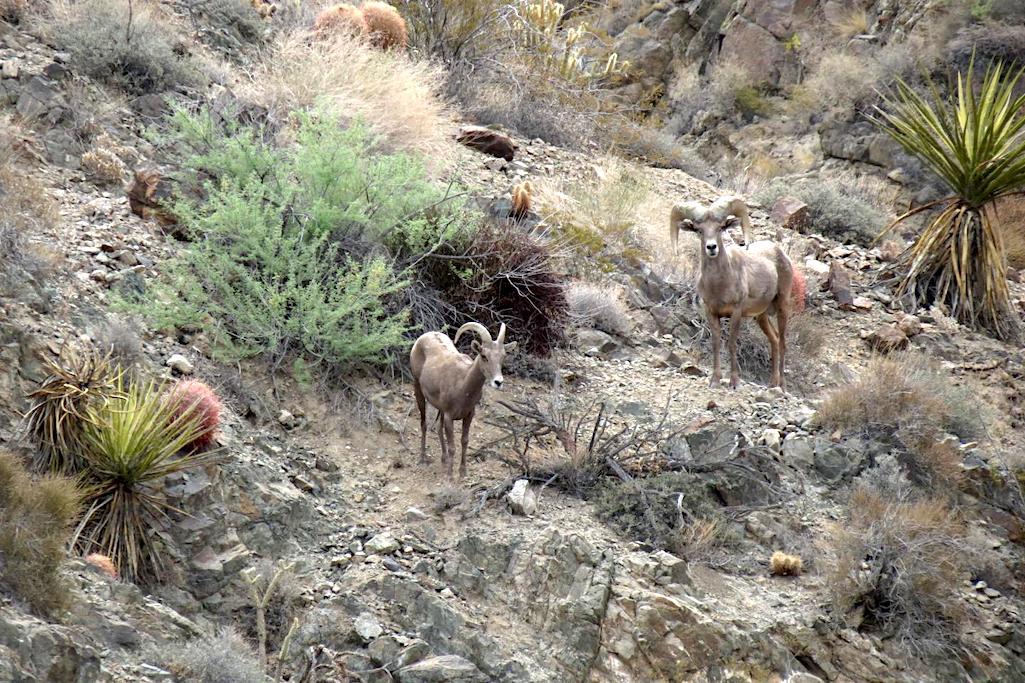
Desert bighorn sheep ewe (left) and ram are observed in the Providence Mountains in the Mojave Desert in California/Rachel Crowhurst, Oregon State University
When four desert bighorn sheep were found dead at Mojave National Preserve in California in 2013, the worst-case scenario was feared. They were killed by a respiratory disease that carried a mortality rate of up to 90 percent, and that carried grave concerns for the preserve's bighorn population. Recent research, however, now suggests that the animals are more resilient to the disease than had been thought.
Bighorn sheep were once common in Southern California and Nevada, but by the 1960s their numbers had been sharply reduced by disease, unregulated hunting, and habitat loss. Forty years of cooperative efforts to rebuild the herds seemed to be paying off until that May day in 2013, when a National Park Service employee found the four dead sheep and spotted other sick animals that appeared to be weak and unsteady with labored breathing.
Surveys in the wake of that day spotted at least 30 other dead bighorns. And a helicopter survey in mid-July indicated that there were significantly fewer sheep than had previously been surveyed in the vicinity of Old Dad Mountain, suggesting a large mortality event occurred.
But now research conducted by a wildlife biologist from Oregon State University indicates that the preserve's bighorn population is more resilient than previously thought to that respiratory disease.
Clint Epps, and several co-authors, found that exposure to one of the bacteria associated with the disease is more widespread among bighorn sheep populations in the Mojave, and that its presence dates further back than scientists thought. But they also found that the overall number of infected bighorn has declined since 2013 in the populations surveyed.
Epps and his colleagues, including Nicholas Shirkey, an environmental scientist with the California Department of Fish and Wildlife and lead author of the paper in the Journal of Wildlife Diseases, are cautiously optimistic about what they found.
"I wouldn't let my guard down, but I have been heartened to see that the bighorn are hanging on," said Epps, a professor in OSU's College of Agricultural Sciences.
The 2013 respiratory disease outbreak puzzled scientists, who grew concerned that the disease could impact the long-term future of one of the few large mammals that can live in Mojave's harsh desert environment. Desert bighorn sheep, which weigh up to 250 pounds, are notable for their large curled horns and ability to climb steep, rocky terrain with speed and agility. They live in California, Nevada, Utah, Arizona, New Mexico and Texas, as well as Mexico.
Epps, who began studying desert bighorn sheep in 1999, said they are a species that brings people together.
"I've seen people from all walks of life - people who are hunters, people who are desert aficionados, people who love biodiversity, people who just love these things for their iconic beauty - all coming together around the conservation management of this species," he said. "I have seen some really unusual partnerships."
Shirkey added that the rare animals captivate people.
"There's fewer than 5,000 desert bighorn in the state of California," he said. "There's probably that many deer in parts of some counties. They live in small numbers in very difficult places and even just seeing one, you feel like you've gotten to have a real special experience."
The paper, published in the Journal of Wildlife Diseases, describes the results from testing blood samples of captured bighorn sheep for antibodies to Mycoplasma ovipneumoniae, a pathogen associated with respiratory disease in the animal.
The 2013 outbreak of the pathogen mobilized interest in the Mojave populations of desert bighorn sheep, leading the California Department of Fish and Wildlife, the National Park Service, Epps and other partners to capture and release more animals to obtain blood samples to check their health and monitor population trends.
The Mojave Desert occupies about 43,000 square miles, of which 59 percent is in California. The California piece of the Mojave is about the size of the state of West Virginia. That large size leads to distinct, though connected, populations of desert bighorn sheep throughout the Mojave in California. The California Department of Fish and Wildlife has captured sheep in 16 different mountain ranges.
In 2013, they captured 70 desert bighorn sheep in eight of those populations. Sixty percent of them had antibodies to Mycoplasma ovipneumoniae, the pathogen that causes the respiratory diseases. In four subsequent years of capturing bighorn sheep in up to 12 of those regions, between 12 percent and 15 percent had the antibodies. While the percentage of bighorn with antibodies has declined across most populations since 2013, the researchers continue to identify additional ranges where the pathogen has been present.
The researchers also tested blood samples that had been collected from desert bighorn sheep during the 1980s, 1990s and 2000s. The samples they tested, which are archived by the California Department of Fish and Wildlife, only represented four of the 16 populations.
The researchers found evidence that bighorn sheep in those populations had been exposed to that pathogen in all three of those decades, leading them to question whether the antibodies were to the same strain as that observed during the 2013 outbreak or a less virulent strain. In one case, a population with evidence of exposure in 1989-90 appeared to have cleared the pathogen several years later, with subsequent tests failing to detect exposure until the 2013 outbreak.
"The findings in the paper show the importance of a sustained effort to collect data from these desert bighorn sheep," Epps said. "The data really help us understand what is happening with these populations so that we can make sure they survive."



Add comment